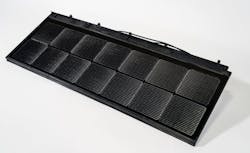Innovative Products: Durable, Low-Profile Solar Shingles
Solar technology continues to advance, breaking the boundaries of what solar panels can do—and how they look. While solar power may still conjure mental images of rectangular, unsubtle panels, a newer approach seeks to blend into traditional shingle roofs while making it easier on installers. A leading example is CertainTeed’s latest Solstice Shingle.
But CertainTeed Field Application Specialist John Hardwick explains that it’s not just about looks for Solstice, which lays on roofs with a very minimal profile.
While the look has become more sophisticated, so has technology and performance, he explains. The Solstice line claims to offer competitive durability, product longevity, and as a result, a leading-industry warranty of up to 25 years.
Plus, CertainTeed says the advancements don’t just benefit the homeowner, but installers too.
RELATED: The Future of Solar: Light-Capturing Windows
“The interior solar cell is the secret sauce to Solstice,” Hardwick says. “The solar cell is about 6 inches by 6 inches square.”
And within this cell is a new cell interconnection technology, making it tougher but easier for installers. Other iterations of the solar cells were razor-thin but easily broken. Solstice Shingles can withstand being stepped on, knelt on, and withstand any accidental handling during install.
To improve design and cut down installation time, the Solstice Shingle uses engineering polymers and eliminates the need for copper grounding wires.
“We’ve saved the cost in the copper and the lugs and just made it a ton easier,” says Hardwick. “While you’re up on the roof, and you’re putting in the screws and connecting the wires, you just want to get off the roof as fast as you can because you’re hot and sweating. Being able to not do that ground wire saves a ton of time and money and effort.”
Plus, installation can be done entirely by a roofer until it’s time to connect the wires. Hardwick says it’s so easy, “anybody can do it on your crew.”
And now’s the perfect time for an enhanced look for solar panels in terms of homeowner demands. As solar panels have been around for decades, the early adopters have welcomed them with open arms. What’s left? The more reluctant homeowners. And with tax incentives, the nudge could be what they need to take the plunge.
“Now you’ve got people who are tire kickers, they want to check prices, they do a lot of internet research, they understand that their house is their biggest asset,” says Harwick.
“So they might not only be looking for the lowest price, they might be looking for something else.”

